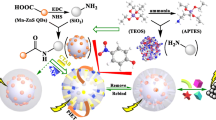Abstract
We recently demonstrated the synthesis and fluorescence activity associated with an optical detector incorporating a molecular imprinted polymer (MIP). Steady-state and time-resolved (lifetime) fluorescence measurements were used to characterize the binding activity associated with MIP microparticles imprinted to dipicolinic acid (DPA). DPA is a unique biomarker associated with the sporulation phase of endospore-forming bacteria. Vinylic monomers were polymerized in a dimethylformamide solution containing DPA as a template. The resulting MIP was then pulverized and sorted into small microscale particles. Tests were conducted on replicate samples of biologically active cultures representing both vegetative stationary phase and sporulation phase of Bacillus subtilis in standard media. Samplers were adapted incorporating the MIP particles within a dialyzer cartridge (500 MW). The permeability of the dialyzer membrane permitted diffusion of lighter molecular weight constituents from microbial media effluents to enter the dialyzer chamber and come in contact with the MIP. Results showed dramatic (10-fold over background) steady-state fluorescence changes (as a function of excitation, emission and intensity) for samples associated with high endospore biomass (DPA), and a frequency-domain lifetime of 5.3 ns for the MIP–DPA complex.
Similar content being viewed by others
REFERENCES
B. Wandelt, A. Mielniczak, P. Turkewitsch, and S. Wysocki (2003). Steady-state and time-resolved fluorescence studies of fluorescent imprinted polymers. J. Lumin. 102–103, 774-781.
G. Gould and A. Hurst (1969). The Bacterial Spore, Academic Press, London.
R. Nudelman, N. Feay, M. Hirsch, S. Efrima, and B. Bronk (1999). In Proceedings of SPIE–The International Society for Optical Engineering 3533 (Air Monitoring and Detection of Chemical and Biological Agents), pp. 190-195.
K. Haupt, P. A. G. Cormack, and K. Mosbach (2002). Imprinted polymers as tailor-made stationary phases for affinity separation. Biochromatography 419-431.
S. Al-Kindy, R. Badia, J. L. Suarez-Rodriguez, and M. E. Diaz-Garcia (2000). Molecularly imprinted polymers and optical sensing applications. Crit. Rev. Anal. Chem. 30, 291-309.
J. R. Lakowicz (1999). Principles of Fluorescence Spectroscopy, 2nd ed., Kluwer Academic, New York.
D. Rosen, C. Sharpless, and L. McGown (1997). Bacterial spore detection by use of terbium dipicolinate photoluminescence Anal. Chem. 69, 1082-1085.
F. W. Janssen, A. J. Lund, and L. E. Anderson (1958). Colorimetric assay for dipicolinic acid in bacterial spore Science 127(3288), 26-27.
Y. Hathout, P. A. Demirev, Y.-P. Ho, J. L. Bundy, V. Ryzhov, L. Sapp, J. Stutler, J. Jackman, and C. Fenselau (1999). Identification of Bacillus spores by matrix-assisted laser desorption ionization-mass spectrometry. Appl. Environ. Microbiol. 65(10), 4313-4319
Author information
Authors and Affiliations
Corresponding author
Rights and permissions
About this article
Cite this article
Anderson, J., Nelson, J., Reynolds, C. et al. Steady-State and Frequency-Domain Lifetime Measurements of an Activated Molecular Imprinted Polymer Imprinted to Dipicolinic Acid. Journal of Fluorescence 14, 269–274 (2004). https://doi.org/10.1023/B:JOFL.0000024558.68095.27
Issue Date:
DOI: https://doi.org/10.1023/B:JOFL.0000024558.68095.27




